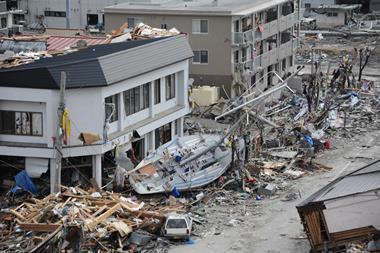Lani Bannach believes that liability risk is becoming ever more important - and interesting
Lani Bannach characterises herself as a 'practical, professional pessimist' - though a realistic one. "Working in risk I am in a position to provide benefits to clients from my knowledge about things that could go wrong or have gone wrong for other people," she explains. "It's sometimes heartbreaking to see a loss develop, when it could have been prevented.
It is, however, interesting that people are more willing to pay for corrective measures after the event, than undertake proper risk assessment in advance, but this is how they tend to react when they are facing uncertainty. I suppose, it is human nature to be optimistic and believe that everything will turn out right. Risk professionals cannot eliminate uncertainty, but we can add value in identifying what the elements of risk are, and the consequences they may have."
What was it that first attracted Bannach to the field of liability risk?
"My whole professional career has been in risk, insurance and finance.
I developed an interest in liability risk, because I was drawn to its complexity. It contains a number of different elements, such as a legal element, an international dimension, a financial aspect, a technical component, often insurance and contingency, and finally there's a human dimension.
I find that fascinating.
"It started back in Denmark, where I was working in a large insurance company and I became involved in complex liability cases to do with products, which had significant financial consequences. The cases required analysis of international law issues, as they involved cross-border sale of goods and services."
It is also a field that has inspired Bannach to gain considerable breadth and depth of expertise and experience. "I have continuously added to my qualifications in order to remain well equipped for working in this field," Bannach explains, "gaining an LL.M, which took five and a half years, an accounting degree to gain the tools of financial analysis and knowledge about accounting principles, with additional education in liability issues while working in the insurance industry. I have also been involved in implementation assessments of new legislation and as a member of various consultative boards reviewing liability-related issues."
The rising level of complexity in the business environment has meant, says Bannach, that liability risk assessment is playing an increasingly vital role in the case of mergers and acquisitions. "What are the elements and sources of liability risk? It is important to know, in order to reach the right price for both buyer and the seller. It is important for the acquirer to have a correct assessment of the target company, to be able to address future liability risks.
Removing uncertainties
What can a liability risk assessment uncover? "Liabilities may be latent, underprovided, or could have a serious impact on a company or its brands' reputation. Many investment valuation models do not take these into account," says Bannach. "In order to tackle these questions you must have industry-specific knowledge, usually involving senior management with operational experience, who have also been through the valuation process before. As a result they will know what to look for and what to do when they find it," she explains.
"Within an organisation they will have the information in some form, but for some reason it may not have been disclosed, or it is not in the data room. With the right expertise you can draw this out of the company being acquired."
In Bannach's experience, examples of sectors where this kind of knowledge is essential include the food and pharmaceuticals sector. Contaminated land is another potential liability.
Bannach takes the case of a company selling a plant. "A property valuation had been provided, but the acquiring company's lawyers wanted an environmental assessment, which proved inconclusive. This was not satisfactory, but we found a way of building various developments into the valuation and hence addressed it financially, including discussing with senior management the impact on reputation if, in the future, contamination materialised and hit the newspaper headlines. It was not just a case of analysing what the cost of the clean up for the liability incurred would be, but what other type of damage it could cause and what might be the consequences."
Consequential analysis of potential events after the acquisition, even as much as two or three years down the line, is a highly important part of risk assessment, according to Bannach. "As M&A lawyers know, you cannot always rely on representations and warranties. We will equip the acquirer with a useful tool for reviewing and maintaining an overview of liability risks. The best situation is that in which the acquiring company proactively ensures that it regularly reviews the new operations until they are fully integrated into the overall risk reviews. It is no longer possible to rely on insurance cover to pick up transitional risks, in that retroactive cover for acquisitions is difficult to obtain in the current market.
"When an acquisition has not gone according to plan and the expected benefits have not materialised, one reason may well be that a latent liability was not identified at the time of the acquisition and subsequently produced a loss, rather than because economies of scale and efficiencies could not be realised. People want to see the benefits of an acquisition as quickly as possible, and they want clarity and transparency so they know what they are getting. For this they need the right expertise at the right time.
"Investment in the right advice can even be a benefit, to the extent of receiving a clean bill of health, once an assessment has been made and all significant issues have been adequately addressed. However, we have only once come across such a well-managed business. They are very rare, because the increasing complexity of legal and regulatory requirements makes it more difficult for managers to stay on top of all aspects."
In the past, insurance might have been seen as a potential answer to many problems. "These days insurers are restricting coverage, and companies are not able to get retroactive cover," Bannach says. "In general, where insurance is concerned, it is worth involving insurers and brokers at an early stage to ensure the ability to negotiate as much continuity and breadth of cover as possible."
The kinds of risk Bannach believes are likely to be important for most companies are not the dramatic and extreme incidents like earthquakes, but the hidden consequences of faulty aspects of day-to-day operations.
"Take, for instance, the issue of breach of licence. Which company can say that the software they have is managed entirely the way it should be? A client of ours recently had an enquiry from a software provider to confirm the number of users covered by their licence. The answer happened to be exactly right. But had the company employed just one extra person, they had no system to automatically amend the licence, nor did they have a process to cater for the need to take this into account. After a recently conducted liability risk review, they now do. "
In fact, the 'earthquakes' most likely to hit companies these days are not physical disasters, but actions taken in court rooms and in the offices of regulators. "Regulatory developments are certainly something which should always be highlighted as an area for monitoring," says Bannach.
"Large international organisations have the capacity to do this, but medium-sized companies might find it more difficult.
"A few years ago, most food manufacturers would have shrugged their shoulders at the suggestion, that their company would be the target of a legal case concerning obesity," says Bannach. "They would have said 'Surely we cannot be held responsible. What people choose to eat is their own responsibility.' Yet now food manufacturers and suppliers have to carefully consider sizes of portions as well as the content of their products, in case they incur a liability and have to pay damages to their obese customers. Legislative and legal developments mean that while it used to be a case of 'buyer beware', we have recently seen the growth of what is almost a 'nanny state'.
I don't always support this development, because there has to be a balance.
"In this sense, in addition to being a practical, professional pessimist, I see a pattern of deteriorating public perceptions about the individual's responsibility for his or her own actions and choices. This increases the liability for all companies and organisations who supply products and services used by consumers. This trend is likely to continue in the future, so it is well worth watching your liability risks."
Journalist Robert Carruthers interviewed Lani Bannach, managing director of ScanConsult, and one of the judges 2004 European Risk Management Awards, Tel: 0120 8761 7111, E-mail: lb@scanconsultinternational.com
WHY UNDERTAKE LIABILITY RISK ASSESSMENT?
Liability risk assessment is one of the key elements of overall risk assessment as part of an acquisition. As such, it aims to:
- Identify the areas and sources of potential or actual risk of liability
- Assess the level of the desired investigation and the required basis for it
- Analyse and assess the significance of liability risk and, where possible, quantify it
- Address and handle the findings, financially or legally, prior to closing
- Develop a plan for mitigating actions and control during transitional and implementation stages following acquisition.
WHAT ACTUALLY HAPPENS DURING LIABILITY RISK ASSESSMENT?
According to recent studies of mergers and acquisitions, more than 60% of them fail to create the value expected or even destroy it. Improving this exceptionally low rate of success is an important goal. Liability risk assessment is one way in which companies making an acquisition can move towards it.
Liability risk assessment has several phases - all carried out, where appropriate, in close co-operation with the client's other professional advisers:
- An industry-specific liability risk identification and a company-specific additional risk identification, based on publicly available information
- Specification of information required for the data room, in particular the documents and staff access needed for the purposes of due diligence
- Determination of the level of the investigation, preferred rating, if any, and valuation criteria
- Specification of time scales and reporting requirements
- Document review and staff interviews
- Assessment, rating and prioritisation of the liability risks. Liaison with financial valuation team for alternative impact calculations
- Reporting of the liability risk assessments.
- Consideration of suggested handling of findings prior to closing
- Consideration of suggested handling of findings after closing.



















